The 2024 Severe Weather Season So Far; Second-most Tornadoes
05/15/2024, 9:20 am EDT
North America Winter 2024-25 Can Expect a “Polar Vortex” in February
08/15/2024, 5:05 am EDTExecutive summary: Majority of forecast models are indicating La Nina development by early-to-middle quarter 4 of 2024. Some models are maintaining neutral ENSO. Current diagnostics favor neutral ENSO. Forecast models are more agreeable to the presence of -IOD. The comparison between -IOD/weak ENSO and La Nina coupled with -IOD yield differences but nothing profound. In general, the -IOD/LA Nina regime offers a wetter solution for Brazil.
Discussion: South America climate is reliant on the El Nino southern oscillation (ENSO) phase. Additional influence, possibly as an enhancer (or suppressor) of the ENSO climate, is phase of the Indian Ocean dipole (IOD). Both leading modes of climate variability are forecast to potentially change phase during Q4/2024 lasting into early next year (Fig. 1-2). Forecast confidence is highest for a shift to negative phase of the IOD. The ENSO forecast is less confident. Most models are forecasting La Nina to develop during Q4/2024 although with varying intensity (Fig. 3). Current climate diagnostics suggest La Nina development may be slow with a delay until late 2024 or early 2025. A climate comparison, using analogs, of -IOD and neutral ENSO plus -IOD/La Nina climate for October to December and January to March is made to identify potential climate risks for South America.

Fig. 1: The NCEP CFS V2 global SSTA forecast projects neutral ENSO and -IOD for November 2024.

Fig. 2: The ECMWF global SSTA forecast projects neutral ENSO and -IOD for November 2024.
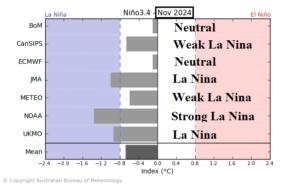
Fig. 3: A collection by the Australia Bureau of Meteorology of dynamic models and their Nino34 SSTA forecast for November 2024.
Methodology: The review is based on the monthly Nino34 SSTA and IOD index. Analogs are taken from the modern climate era which began in the middle 1990’s. At that time, the long-term cycle of ENSO changed from the warm to cool phase. Additionally, climate change has notably accelerated since the middle 1990’s and particularly the past 10-15 years, most notably in the warming of the non-tropical oceans.
The analog years for -IOD and neutral ENSO to weak La Nina are 2022, 2016, 2005, and 1996. The -IOD occurring with strong La Nina is 2010 and 1998. The IOD/ENSO relationship is well established for Q4 losing intensity early the following year. Therefore, a comparison between OCT/NOV and DEC/JAN for the two regimes identified is provided.
Results: The comparison between -IOD/weak ENSO and -IOD/La Nina for OCT/NOV have similarities. Both oceanic regimes are causal to dryness across Northeast Argentina to Southeast Brazil with wet climate on the central East Coast region (Fig. 4-5). The stronger La Nina and -IOD combination has tendency to have a wetter climate in Brazil and drier regime in Northeast Argentina/Southeast Brazil to Paraguay. The -IOD/weaker ENSO regime is drier over Central Brazil.
During DEC/JAN, the IOD/ENSO correlation is slightly weaker. The -IOD and weak ENSO ocean climate is correlated to dryness over Northeast Argentina/Southeast Brazil and Northeast Brazil with a weak wet anomaly just north of Paraguay (Fig. 6). The -IOD/La Nina climate causes a wetter regime in Southeast and Northeast Brazil while dry anomalies remain in Northeast Argentina to Southeast Brazil (Fig. 7).
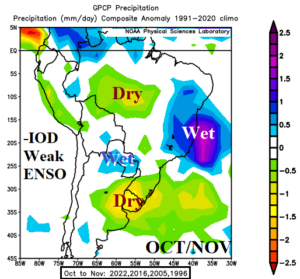
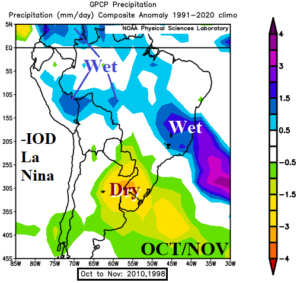
Fig. 4-5: A comparison for OCT/NOV across Argentina and Brazil when IOD is present, and ENSO is weak (left) and -IOD when a fortified La Nina is present.
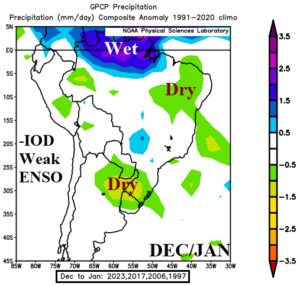
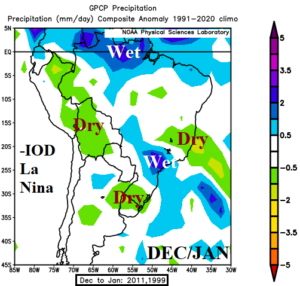
Fig. 6-7: A comparison for DEC/JAN across Argentina and Brazil when IOD is present, and ENSO is weak (left) and -IOD when a fortified La Nina is present.
Results: While differences exist between the -IOD/weak ENSO and -IOD/La Nina precipitation regimes across Argentina/Brazil for both OCT/NOV and DEC/JAN they are not particularly profound. The -IOD/La Nina regime is wetter in Brazil.
